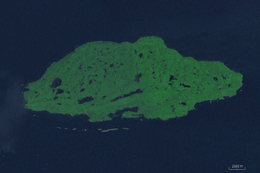Michipicoten Island
 Landsat view of the island. | |
| Geography | |
|---|---|
| Location | Lake Superior |
| Coordinates | 48°44′N 85°45′W / 48.733°N 85.750°WCoordinates: 48°44′N 85°45′W / 48.733°N 85.750°W |
| Area | 184 km2 (71 sq mi) |
| Administration | |
|
Canada | |
| Province | Ontario |
| District | Thunder Bay District |
| Demographics | |
| Population | Uninhabited |
Michipicoten Island is an island in Ontario, Canada, in the northeastern part of Lake Superior, about 175 kilometres (109 mi) northwest of Sault Ste. Marie and 65 kilometres (40 mi) southwest of Wawa, Ontario.[1] It falls within the boundaries of Thunder Bay District.
The third largest island in Lake Superior,[2] Michipicoten Island is 27 kilometres (17 mi) long and 10 kilometres (6.2 mi) wide at its widest point. Uninhabited by humans and with plentiful wildlife (notably beaver, woodland caribou, and birds), it has become a destination for some adventurous kayakers. At its closest point to mainland Ontario, the island is located about 16 kilometres (9.9 mi) from land.[1]
The entire island is administered by Ontario Parks as Michipicoten Island Provincial Park. The island is made up of ancient lava bedrock related to volcanism of the Midcontinent Rift System[2] and is heavily forested, with several inland lakes.
A lighthouse was established in 1912 on the eastern end of the island.
On some old maps, Michipicoten Island is shown as Isle Maurepas, after the French minister of Marine Jean-Frédéric Phélypeaux, Count of Maurepas.[3] The word Michipicoten is an Anglicization of the original Ojibwe word "Mishipikwadina" meaning "big bluffs" in Ojibwe, and is a reference to the geography of the nearby Michipicoten River.[4]
References
- 1 2 Ontario Ministry of Natural Resources (2004). Michipicoten Post and Michipicoten Island Provincial Parks Management Planning: Background Information (PDF). Queen's Printer for Ontario. ISBN 0-7794-6544-X. Retrieved April 18, 2014.
- 1 2 Ontario Ministry of Natural Resources (July 2, 2013). "Natural Heritage Information Centre". Queen's Printer for Ontario. Retrieved April 18, 2014.
- ↑ Schwartz, Seymour I. (2008). The Mismapping of America. Rochester, NY: University of Rochester Press. pp. 192–195. ISBN 9781580461290.
- ↑ Kelton, Dwight H. (1889). Indian Names and History of the Sault Ste Marie Canal. Detroit: Detroit Free Press Printing Co. pp. 24–5.
External links
- Ontario government documents regarding Michipicoten Island
- Description of a commercial kayaking trip to Michipicoten Island, with information about the island
- 1910 Log Book of the North Shore Club: Michipicoten / Wawa Region History
- Story of two sea kayakers rescued by the Coast Guard off Michipicoten Island